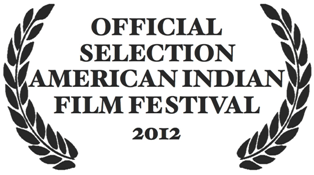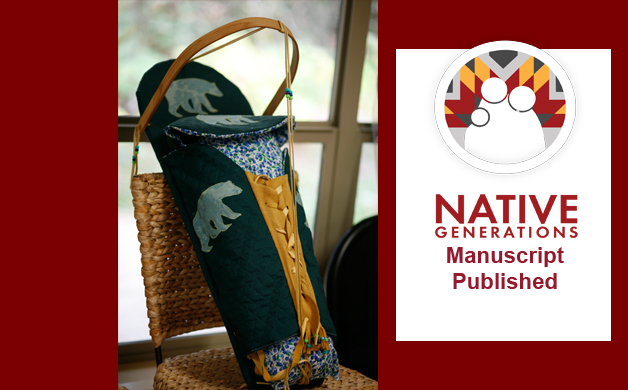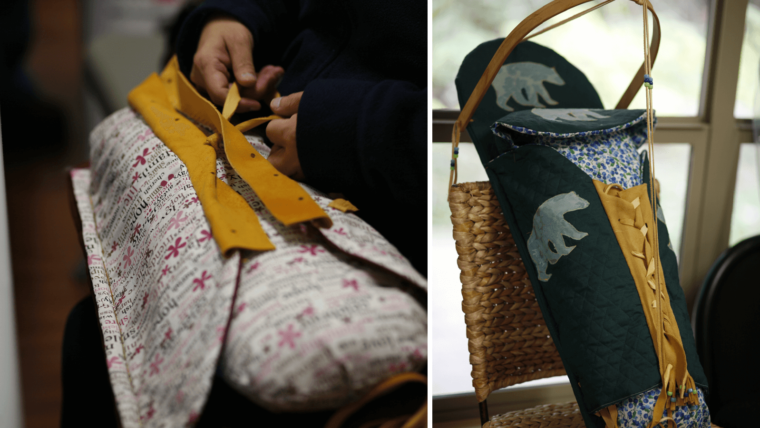The Native Generations campaign emphasized connection to culturally grounded health care and community services to promote healthy families and prevent infant deaths among American Indians and Alaska Natives.
The campaign video:
- Shares the stories of young urban AI/AN parents that are staying connected to their culture and community for the health of their families.
- Promotes a nationwide network of Urban Indian Health Programs that provide health services, cultural activities and connection to community support.
- Reveals challenges to infant health, safety practices and other health risks.
- Highlights examples of innovative and vital programs for Native families in two cities.

Manuscript

The American Indian Alaska Native Mental Health Research journal published an article entitled “Native Generations: A Campaign Addressing Infant Mortality among American Indians and Alaska Natives in Urban Areas.” The Native Generations campaign was a pilot project aimed to address disparities in rates of infant mortality in American Indian and Alaska Native (AI/AN) communities and the general population. Former UIHI staff, Shira Rutman MPH and Julie Loughran MPH, co-authored the work with Leah Tanner (Seattle Children’s Hospital), and Leslie L. Randall, RN, MPH, BSN (NiMiiPuu Health Board, Nez Perce Tribe). The campaign produced an 11-minute video which featured families, providers, and community members from diverse tribal and geographic backgrounds.
The major objectives of the project were:
- Increase awareness of rates of, and risk of protective factors for IM
- Increase awareness of UIHOs as Native-specific resources for health care, support services, programs and community
- Increase utilization of Native-specific resources
- Increase connection to native identity, culture, and community
The manuscript walks the reader through the project’s methodology, campaign planning and strategy development, literature review process, creation and testing, implementation, evaluation, and preliminary findings. The preliminary findings conclude that 100% of AI/AN viewers liked the video and that the vast majority (80.4%) thought the video increased awareness of infant mortality rates and risk for infant mortality. This suggests that the Native Generations pilot study successfully met the project objectives. Going forward, the authors suggest that future studies should look at indicators that measure changes such as the utilization of Native-specific resources, baseline IM knowledge, and evaluation of retention of information in order to collect the necessary information to support a full-scale of the Native Generations campaign.
View the manuscript in the American Indian and Alaska Native Mental Health Research journal »
Video Resources
Resources for Families
This Website Resources List provides direct support, resources, and information to new or expecting parents and caregivers. Also available as a PDF document.
American Indian/Alaska Native Specific Resources
- Breastfeeding for American Indian and Alaska Native Families booklet (U.S. Department of Health and Human Services)
- Native Breastfeeding Council
- Coming of the Blessing
- Honor the Past, Learn for the Future: Reduce the Risk of Sudden Infant Death Syndrome flyer
- Safe Sleep For Your Baby brochure (U.S. Department of Health and Human Services, Eunice Kennedy Shriver National Institute of Child Health and Human Development)
General Websites
- Information for pregnancy and after the baby arrives (Centers for Disease Control and Prevention)
- Questions & Answers for health topics on pregnancy and after baby is born – includes sections just for dads (National Healthy Babies, Healthy Mothers Coalition)
- Text4Baby – Weekly health tips during pregnancy and one year after your baby is born (National Healthy Babies, Healthy Mothers Coalition)
- Information about diabetes during pregnancy (Centers for Disease Control and Prevention)
- Postpartum depression information (Centers for Disease Control and Prevention)
- Resources about services and support for families (Maternal & Child Health Library at Georgetown University)
- Parenting resources for new dads (National Fatherhood Initiative)
- Community Services Locator (Maternal & Child Health Library at Georgetown University)
- Healthy Start – Community-based maternal and child health programs
- WIC (Women, Infants and Children) – Special Supplemental Nutrition Program
- Child Care Aware – Child care resources (Also Finding Help Paying for Child Care – information about financial assistance available)
- National Sudden Unexplained Infant Death (SUID) / Sudden Infant Death Syndrome (SIDS) Resource Center
- Protect the Ones you Love – Safety information (Centers for Disease Control and Prevention)
- Help for domestic violence (National Network to end Domestic Violence)
- Child Help – Prevention and treatment of child abuse
- Safe to Sleep (Eunice Kennedy Shriver National Institute of Child Health and Human Development)
Please contact us if you have ideas for resources to add here!
Reports
To learn more about maternal and child health among urban American Indians and Alaska Natives nationwide and the information referenced in the video, read our reports.
Updated: Jan 3, 2017
This new manuscript walks the reader through the project's methodology, campaign planning and strategy development, literature review process, creation and testing, implementation, evaluation, and preliminary findings. The preliminary findings conclude that 100% of AI/AN viewers liked the video and that the vast majority (80.4%) thought the video increased awareness of infant mortality rates and risk for infant mortality. This suggests that the Native Generations pilot study successfully met the project objectives. Going forward, the authors suggest that future studies should look at indicators that measure changes such as the utilization of Native-specific resources, baseline IM knowledge, and evaluation of retention of information in order to collect the necessary information to support a full-scale of the Native Generations campaign. (October 2016)
Updated: May 6, 2011
The qualitative research project described here was designed to gather opinions and insight from American Indian and Alaska Native (AI/AN) parents about “keeping babies healthy and safe” and effective messages and communication channels for information on these topics. The project took place in four urban communities nationwide. In this report we describe the results obtained from focus groups and individual discussions, which will be used in the development of a communications campaign to address high rates of infant mortality among AI/ANs in urban areas and beyond. (May 2011)
Updated: Jan 6, 2011
There are three aims for this report: 1) outline the burden of infant mortality and associated risk factors and barriers to improvement among AI/AN nationwide, 2) provide an overview of the health communication campaigns that have been directed to this population including the range of topic areas and methods for reaching AI/AN and 3) discuss select previous and current efforts on infant mortality prevention among AI/AN. (January 2011)
Updated: May 6, 2010
This report provides a national picture of reproductive health and sexual violence for AI/AN women living in urban areas. The study is the first to examine data from the National Survey of Family Growth for this population. Findings show American Indian and Alaska Native women living in urban areas were more likely than non-Hispanic whites to report: non-voluntary first sexual intercourse, unintended and teen pregnancies, unprotected first sex and first sex with older partners. Rates of female sterilization and use of Depo-Provera were also greater among AI/AN compared to non-Hispanic whites. An Executive Summary may also be found here. Also see News Coverage. (May 2010)
Updated: Dec 6, 2009
The UIHI conducted a Maternal, Infant and Child Health Capacity Needs Assessment to ascertain the maternal, infant and child health (MICH) services as well as the accessibility, quality, and affordability of those services provided by the 34 urban Indian health organizations (UIHO) funded through Title V of the Health Care Improvement Act. The purpose of the assessment was to assist in identifying specific assets, limitations or gaps in the urban Indian health program as a whole. (December 2009)
Updated: Mar 6, 2009
This report provides a review of the urban AI/AN youth population and their health risk behaviors from four national data sources. Where available, census and vital statistics data are provided for the U.S. counties served by the 34 non-profit urban Indian health organizations that contract with the federal Indian Health Service. (March 2009)
Acknowledgements
The Native Generations video was produced by Longhouse Media and Urban Indian Health Institute.
The video was supported through a grant by the U.S. Department of Health and Human Services, Office of Minority Health and in part by funding from the Indian Health Service.
We are grateful to the families and staff members who were interviewed for the video and let us into their homes, offices and lives to help tell their stories (listed here in order of appearance):
- Victoria Cadotte-Burton and family, Detroit, Michigan
- Aren Sparck and family, Seattle, Washington
- Jerilyn Church, Former Executive Director, American Indian Health and Family Services
- Annette Squetimkin-Anquoe, Traditional Health Liaison, Seattle Indian Health Board
- Sheena Brown and family, Seattle, WA
- Rosebud Schneider-Bear and family, Healthy Start Outreach, American Indian Health and Family Services
- Nina Marie Eusani, Maternal-Child Nurse, Healthy Start Program, American Indian Health and Family Services
- Kimberly Navarrette, Joseph Warner and family, Detroit, Michigan
- Native Healthy Start playgroup
- Venice Brown, Victoria Ugartechea and the Seattle Indian Health Board perinatal support group
We would like to thank the staff and community members at the American Indian Health and Family Services of S.E. Michigan, the Sacramento Native American Health Center, Inc., the Seattle Indian Health Board and the Urban Indian Center of Salt Lake for their continued involvement in and support of this project.
We would also like to thank the members of UIHI’s Native Generations Advisory Council for their guidance throughout the project.
The Native Generations name, logo and postcard were designed by DGTL/NVJO.
The video includes excerpts from the following artists and songs:
- “Native Drum” by Native Lens Live Recording
- “I Herd They Cut Off Toes for That” by Illest-Rated Abilitys
- “The Youth Conference” by Quese IMC
- “Little Baby” by The Faded Tapes
- “Like a Wolf With Rotten Teeth” by The Scarecrow Frequency
- “Traditional” by Aren Sparck

